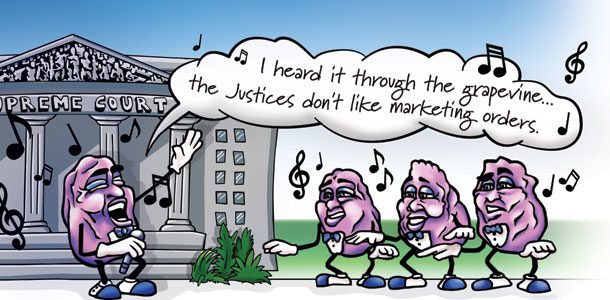Two years ago, I wrote an article about a challenge to the federal marketing order for raisins. Then, the Supreme Court held that raisin growers who had a portion of their crop seized for “reserve marketing” could challenge the legality of the regulations the USDA utilized to establish these reserve marketing pools.
Essentially, the raisin marketing order artificially controls the amount of raisins on the market by holding back a percentage of each grower’s production to inflate prices. In 2013, the Supreme Court sent the case back to the lower courts to determine if the raisin growers were subject to an unconstitutional taking of property without just compensation.
The case wound its way back to the Supreme Court, and on June 22, 2015, the court determined that the raisin reserve program is an unconstitutional taking of property in violation of producers’ due process rights. What does the decision mean for the federal milk marketing orders, which are governed by the same federal law – the Agricultural Marketing Agreement Act?
Briefly, no one should be immediately panicked that the federal milk marketing orders are going to vanish as a result of this decision. The decision is very specifically tailored to the question regarding the raisin marketing order and its reserve pool provisions. That being said, there are some really interesting comments in the Supreme Court’s opinion worth scrutinizing a bit.
First, the opinion (authored by Chief Justice Roberts) makes very clear that the salient point with respect to the raisin order is the actual physical taking of raisins from growers by the government. The Chief Justice explains that, “the reserve requirement imposed by the Raisin Committee is a clear physical taking. Actual raisins are transferred from the growers to the government.” The physical seizure of raisins here is of critical importance.
Seizure of property by the government must be accompanied by just compensation. This legal principle is, as of this year, 800 years old. It was first included in the Magna Carta, and the Supreme Court briefly discusses how this protection of personal property was incorporated first in colonial law and ultimately the U.S. Constitution. Absent the physical confiscation of property by the government, proving that government action has risen to the level of a property taking is a much more daunting task.
To prevail on a claim that governmental regulation alone has risen to the level of a property taking mandating compensation, the persona claiming a regulatory seizure must establish that the owner has been entirely deprived of all property rights. In the case of raisins, the fact that the reserve raisin production is held by the government is sufficient enough to constitute a taking.
Other regulatory actions that have a clear economic impact on the value of property but that do not involve an actual government seizure might not be (and in most cases are not likely) a taking. In fact, Chief Justice Roberts explains that imposition of a regulatory limit on the quantity of raisins any producer could market (and also presumably the price at which they could be sold) would have the same economic effect as a seizure. But regulation that falls short of a seizure is not per se unconstitutional.
This reasoning addressed one of the questions I raised in my previous article. Then, I wondered if a supply management component to the Dairy Security Act would survive a constitutional review. Based on this opinion, I would reason that it would. After all, a supply management provision is exactly the kind of regulatory limit on production the chief justice discussed in his opinion.
Likewise, the argument that the Federal Milk Marketing Orders affect a regulatory taking of producer milk by delivering to them less value than might otherwise be available to any individual producer absent market-wide pooling would face a significant challenge.
In a dissenting opinion, Justice Sotomayor synthesizes a number of prior precedents to illustrate that economic harm resulting from regulation is not a violation of due process protections. She writes that regulations that reduce the value of property is not necessarily a taking nor is “a significant restriction” limiting the ability to sell property, and “not every injury to property by governmental action amounts to a taking.”
Regardless of the actual economic effects of market regulation, it is the physical seizure of property that runs afoul of the due process clause here – not the economic impact.
And finally, in continuing a theme from the 2013 Supreme Court case concerning the raisin marketing order, there is a not-so-subtle jab at the marketing orders as a whole. Justice Sotomayor writes that the court “… is not concerned with whether the order is a good idea now, whether it was ever a good idea, or whether it intrudes on some property rights. The order may well be outdated, and by some lights downright silly, regulation. It is also no doubt intrusive.”
Ouch.
This decision might not cast a great deal of question about the constitutionality of the federal milk marketing order system. But it does continue a pattern of judicial skepticism about the wisdom of its wisdom and continued relevance. PD
ILLUSTRATION: Illustration by Mercedes Opheim.

-
Ryan Miltner
- Attorney
- The Miltner Law Firm LLC
- Email Ryan Miltner








